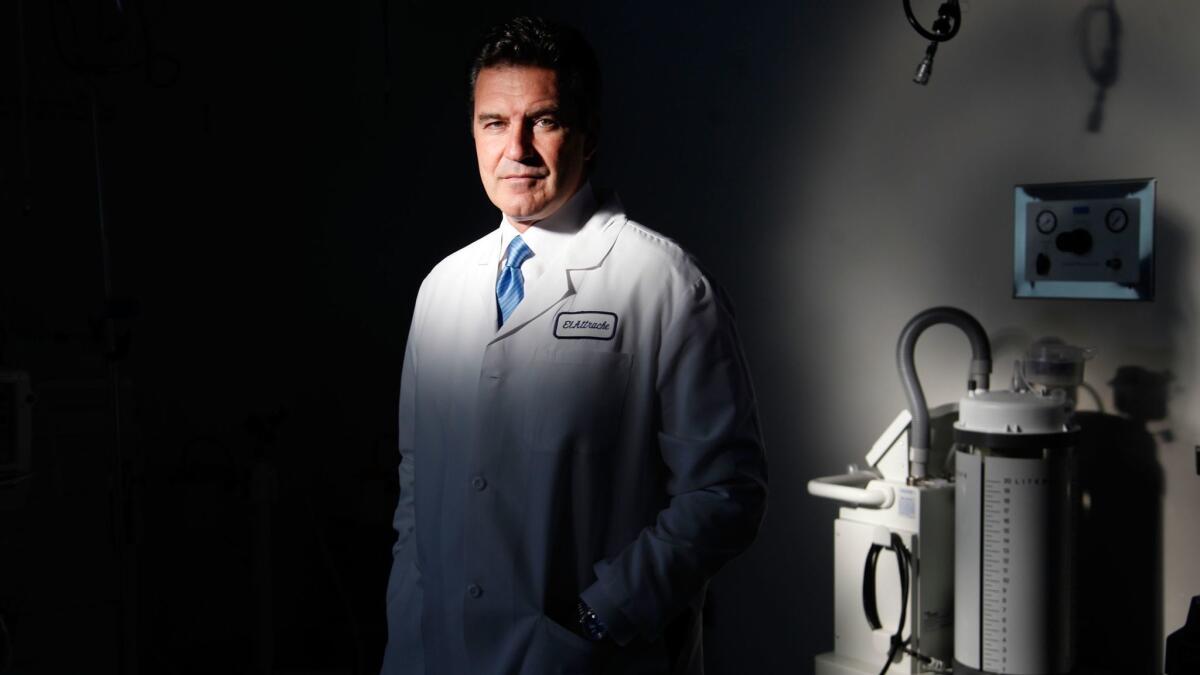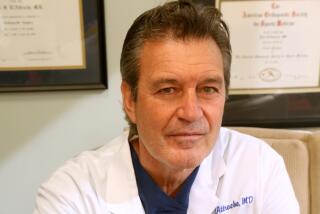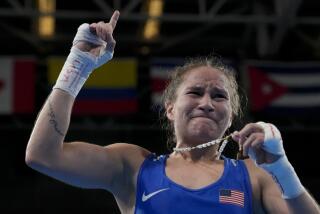Column: Neal ElAttrache’s understanding of boxing makes him an ideal surgeon for Vasiliy Lomachenko

- Share via
He’s widely recognized as the best at what he does.
He’s good looking to where one of his famous male patients once gushed about him — “He’s too damn handsome to cut on me. But I let him.”
And if that’s not enough to work up a healthy measure of jealousy toward Dr. Neal ElAttrache, here’s something else to consider: He can almost certainly kick your you-know-what.
Seriously.
The Los Angeles-based orthopedic surgeon was once a champion boxer in college.
“Oh yeah?” Vasiliy Lomachenko asked.
When Lomachenko defends his world lightweight championship against Anthony Crolla on Friday night, ElAttrache is expected to be at Staples Center in support of his former patient. As close as Lomachenko and ElAttrache have become over the last year, the doctor has never told the fighter about his own pugilistic triumphs.
“The last thing you want to do is tell a guy like Vasiliy Lomachenko, ‘Hey, guess what? I boxed and beat up some frat boys in college,” the self-effacing ElAttrache said with a laugh.
But as Lomachenko reflected on some of the medical advice he received from ElAttrache, it started to make sense to him that the doctor had a background in the sport.
“It looks like he understands boxing,” Lomachenko said.
The understanding has proven critical for Lomachenko in his recovery. A contender for the mythical crown as the No. 1 pound-for-pound boxer in the world, the 31-year-old Ukrainian had his right shoulder surgically repaired by ElAttrache last year.
In the week leading up to his mandatory defense against the underwhelming Crolla, Lomachenko spoke about wanting to make boxing history. However, before he seriously entertains a showdown with Mikey Garcia or attempts to become the undisputed champion of a lightweight division that is an entire weight category above his optimal fighting weight of 130 pounds, Lomachenko has to be Lomachenko again.
Lomachenko wasn’t himself when he returned from the operation on his right shoulder to defeat Jose Pedraza by a lopsided decision in December, as he was unable to deliver hooks with his lead hand out of his southpaw stance.
As ElAttrache said would be the case.
Lomachenko said he will enter his fight against Crolla with his entire arsenal.
As ElAttrache said would be the case.
“He’s a very good man,” Lomachenko said. “He’s a very smart doctor.”
ElAttrache’s assistance went beyond the operation. By correctly describing to Lomachenko what he would experience in his recovery, he provided the fighter with comfort — specifically, comfort in knowing that what he was experiencing was normal. Because of his familiarity with the sport, ElAttrache was able to speak to Lomachenko in ways he could relate.
“It helped because I knew the mechanics of it,” ElAttrache said.
With a list of former patients that includes Kobe Bryant and Tom Brady, ElAttrache is known a surgeon to the stars. ElAttrache himself has become a star in the field of sports medicine.
But ElAttrache was raised under considerably less glamourous circumstances, in a coal-mining borough 45 miles southeast of Pittsburgh called Mount Pleasant. ElAttrache was encouraged to learn to defend himself by his father, who was the town’s doctor.
“He was from Southern Lebanon,” ElAttrache said. “Fighting over there was a lot more deadly than this, but he understood what it would be like growing up in a town like that.”
ElAttrache started training as a teenager.
ElAttrache went to the University of Notre Dame, where organized boxing was first introduced by then-football coach Knute Rockne as an offseason conditioning program for his players. Starting in 1931, the school staged a fundraising intramural tournament to raise money for missionaries to provide education and health care in Bangladesh. Known as the Bengal Bouts, the tournament continues to be staged annually, with the finals broadcasted online by ESPN.
Past Bengal Bout champions include Mike Lee, a three-time winner who was signed in 2009 by Top Rank, the same company that promotes Lomachenko.
ElAttrache is another former Bengal Bouts champion. As a freshman in 1978, ElAttrache won the 185-pound division. The school newspaper reported that his opponent in the final scored early with his powerful left, but that ElAttrache “came out better in the exchanges sporting a quick jab that racked up points.” ElAttrache won a unanimous decision.
ElAttrache didn’t mention the victory to his father.
“I was about 215 pounds the last time my dad had seen me in the fall,” ElAttrache said. “I came home in spring break and I was about 185 pounds. He looked at me said, ‘Why did you lose so much weight?’ I was afraid to tell him.”
ElAttrache knew his father was concerned about head injuries and knew he would disapprove of his participation.
“A few days later, it came out in our local newspaper that I had won,” ElAttrache said. “He threatened to come and take me out of school. He was not happy.”
Uh-oh.
“Then I heard he going around town bragging to all his friends,” ElAttrache said with a chuckle.
ElAttrache never considered making a career out of boxing, but what he learned later helped him treat the likes of Michael Moorer, Vitali Klitschko, Shane Mosley and Manny Pacquiao.
In the case of Lomachenko, the fighter dislocated his right shoulder when he threw a hook early in his fight against Jorge Linares in May of last year. ElAttrache repaired Lomachenko’s labrum and reattached ligaments.
Lomachenko continued to receive advice as he rehabilitated his shoulder.
“He explained me to what I can or can’t do,” ElAttrache said.
In late July, ElAttrache received word that Lomachenko was seriously thinking of returning to the ring the following month. ElAttrache’s advice was simple: don’t.
And as Lomachenko prepared for his comeback against Pedraza in December, ElAttrache cautioned him against using his right hook in training. ElAttrache explained to him that not throwing the punch in training would likely prevent him from delivering it in the actual fight.
Sign up for our boxing and MMA newsletter »
Even if his shoulder was healed, his mind wasn’t.
“When that arm goes into that position, the brain remembers that was the position where that dislocation occurred,” ElAttrache said. “It takes time to overcome that apprehension.”
When Lomachenko was told to construct a fight plan that didn’t include the right hook, he listened. When Lomachenko discovered he was indeed reluctant to throw the punch, he remained calm.
Lomachenko trusted his doctor. He is now ready to trust his shoulder again.
More to Read
Go beyond the scoreboard
Get the latest on L.A.'s teams in the daily Sports Report newsletter.
You may occasionally receive promotional content from the Los Angeles Times.










